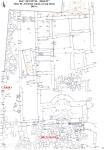Summary (English)
DEULTUM (Krasimira Kostova – kr.kostova@mail.bg) The excavations continued in the western part of the thermae with the adjacent cardo. Debris of houses of the 7th – 8th centuries AD were explored, dated by coins of Phocas, Constantine V Kopronymos, a lead seal of Elpidios, the Logothetes of the Dromos (AD 760 – 775/780) and pottery, including amphorae of Type Hayes 30. A water-conduit of the end of the 4th – beginning of the 5th centuries AD was discovered, dated by a coin of Arcadius. An occupation level of the second half of the 6th century AD, during the reign of Justinian I and Justin II, was documented. Room 4 was excavated, dated to the first half of the 6th century AD and burned after the middle of the 6th century AD. The finds included amphorae of Kuzmanov VI Type, Type Hayes 4B, LRА1, LRА2 and LRА4. Beneath the floor level, a semifollis (20 nummi) of Anastasius I Dicorus minted in AD 512/518 and 10 nummi of Justinian I minted in AD 557/558 were discovered. A fire was documented in Room 3, containing debris of burned fragmentary sun-dried bricks, burned wooden beams and tegulae. A fragment from a Roman military diploma was found, with a decree of Hadrian issued on the 17th July 122 AD, which featured the dismissal of retired soldiers from the auxiliaries in the Roman province of Dacia Inferior with provincial governor Cocceius Naso. The coins from the layer with traces from fire gave AD 347 – 348 as temimus post quem and AD 358 as terminus ante quem. The eastern wall of Room 3 was built over the wall of the Roman thermae. The suspensura of the destroyed hypocaust of the thermae contained fragmentary terracotta tubi, bricks and marble veneer, and consisted of terracotta tubular pilae, 27 cm in diameter and 80 cm in height. The walls were plastered with hydraulic mortar. Two storage rooms were discovered, with traces from fire of the second half of the 5th century AD, dated by coins of Theodosius II; seven dolia, fragmentary amphorae and pots, terracotta lamps and two Gothic pots were also found there. The western cardo was paved with stone slabs and probably was used until the beginning of the 6th century AD.
- Krasimira Kostova - Museum of History – Sredets
Director
- Krasimira Kostova - Museum of History – Sredets
Team
Research Body
- Museum of History – Sredets






![Download [PDF]](/excavation/skins/fasti/images/results/download_sml.png)
